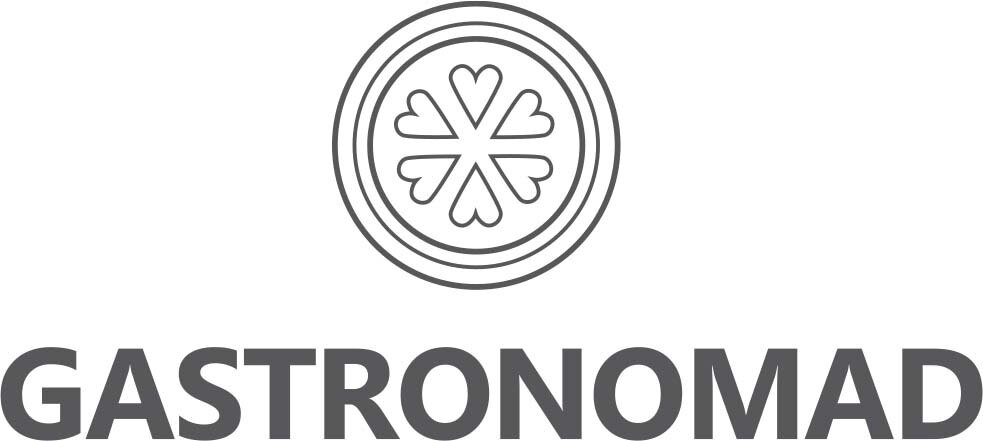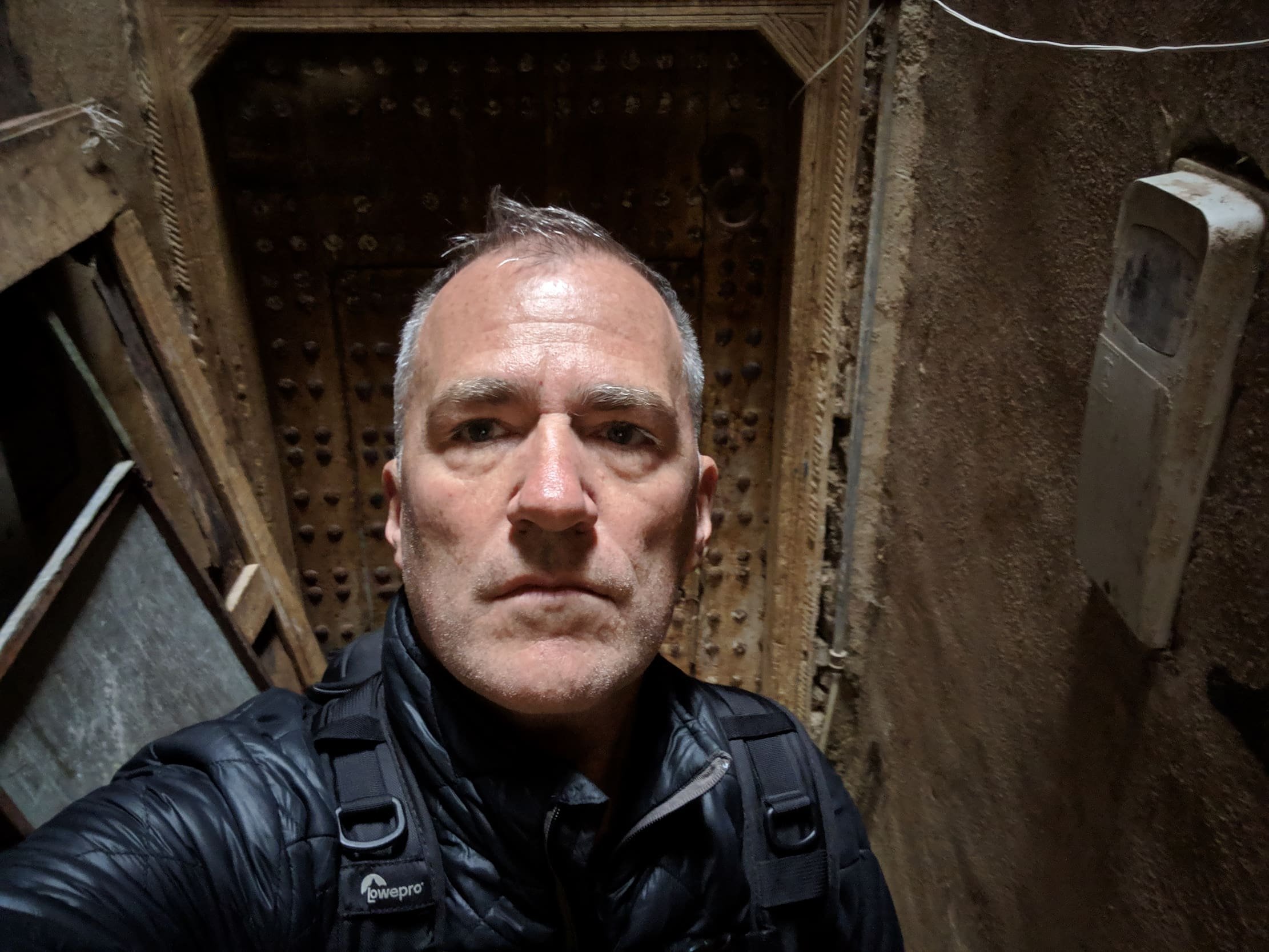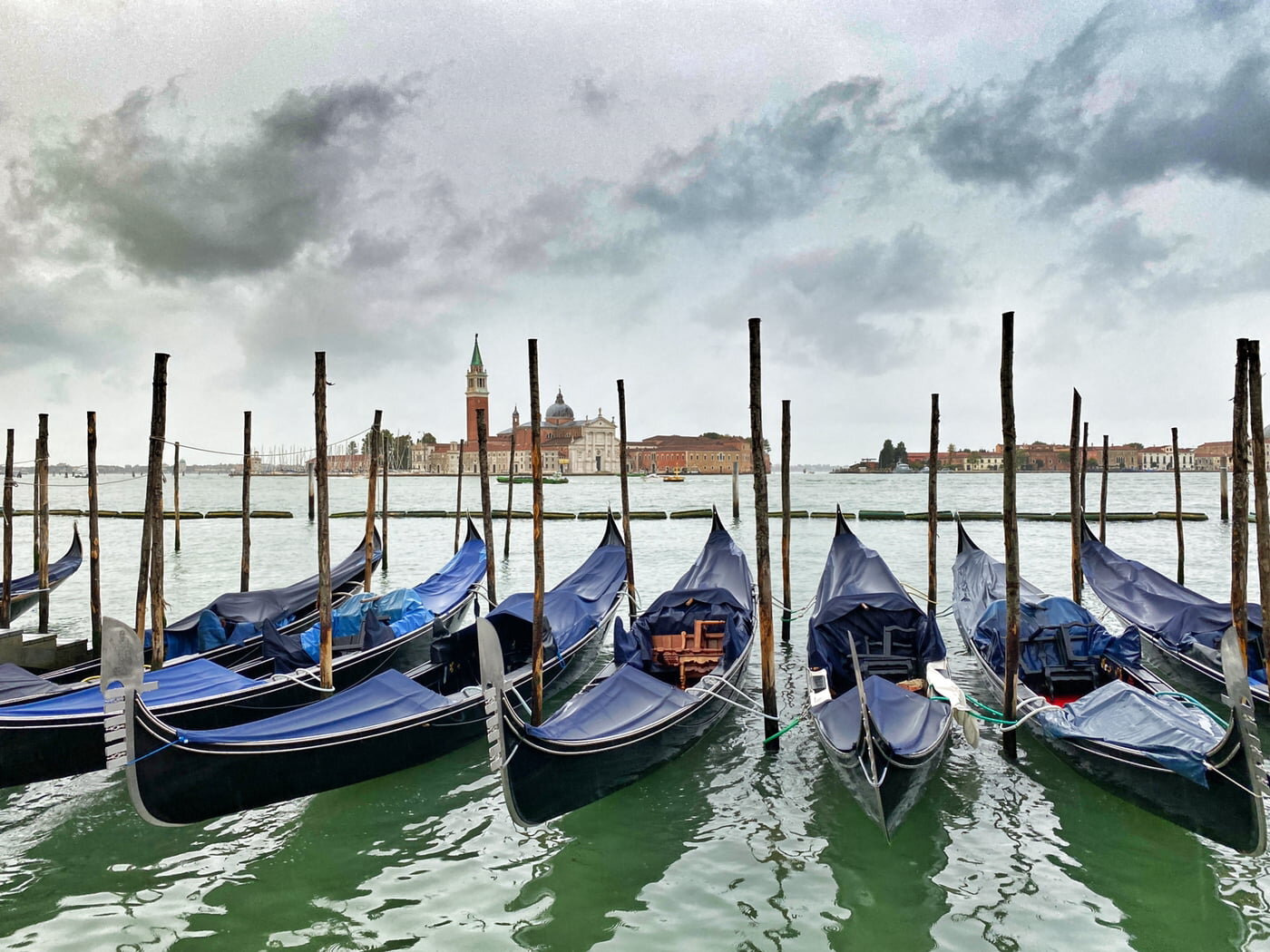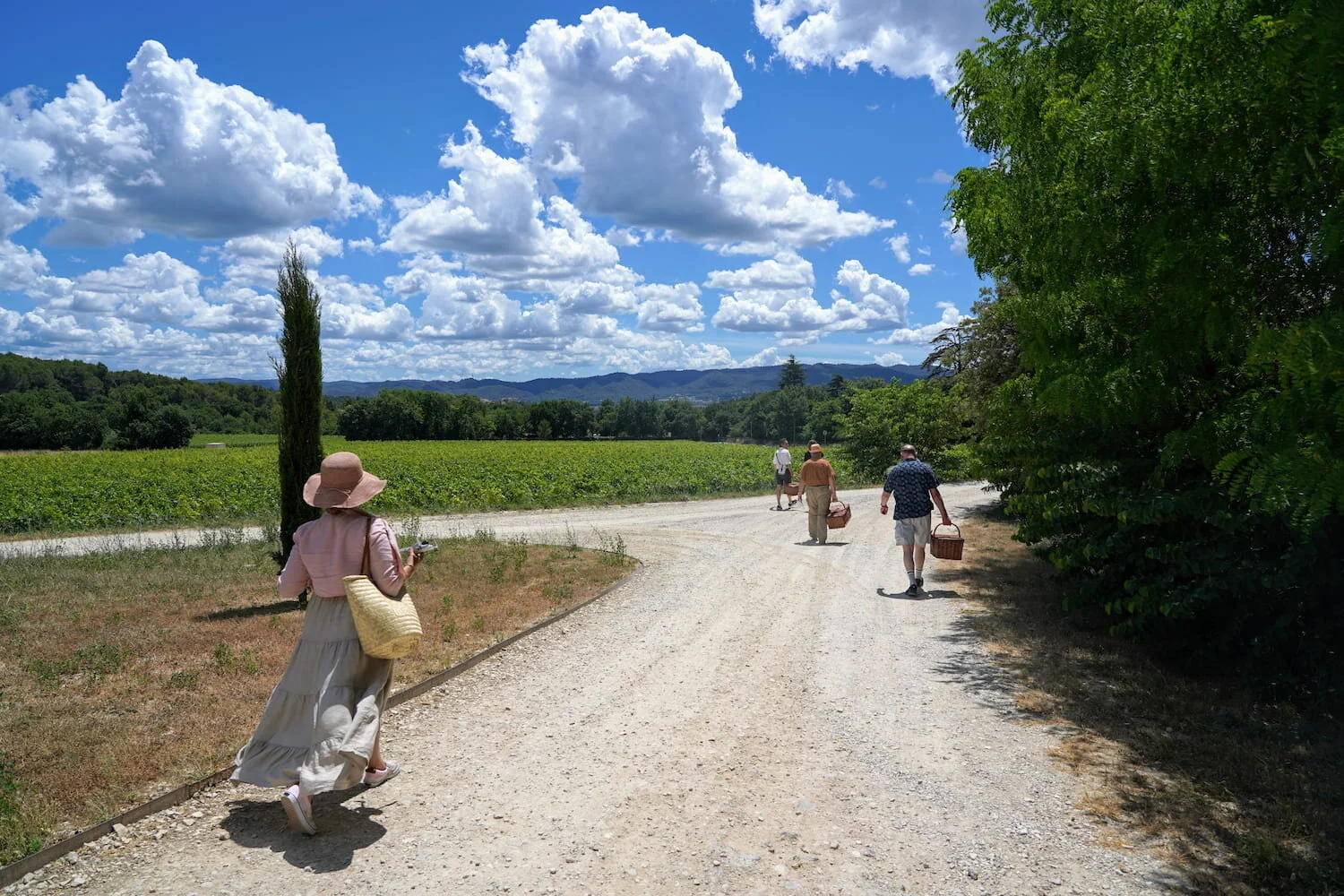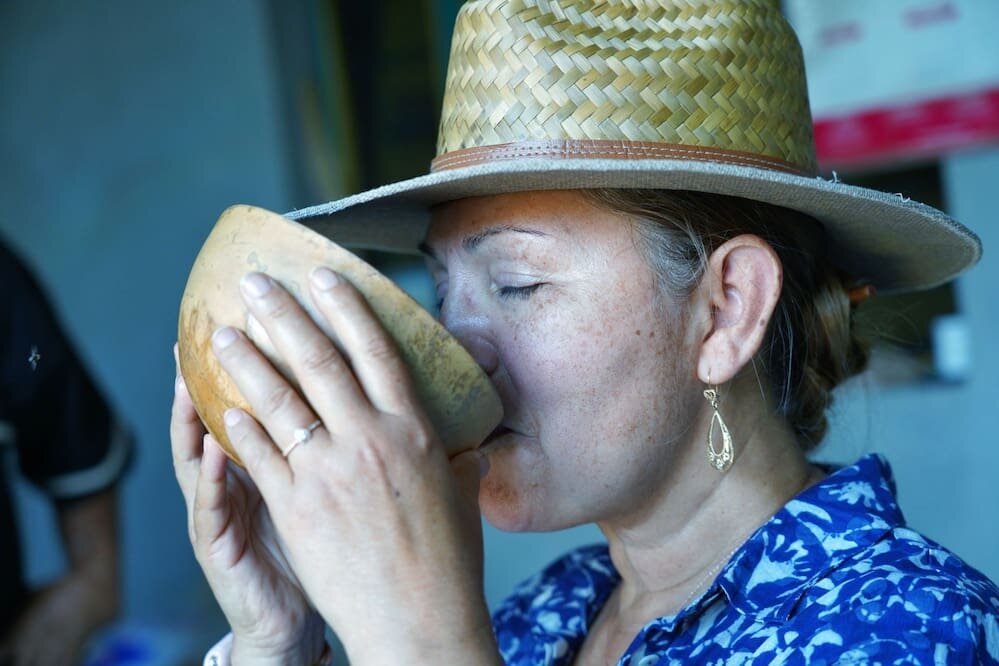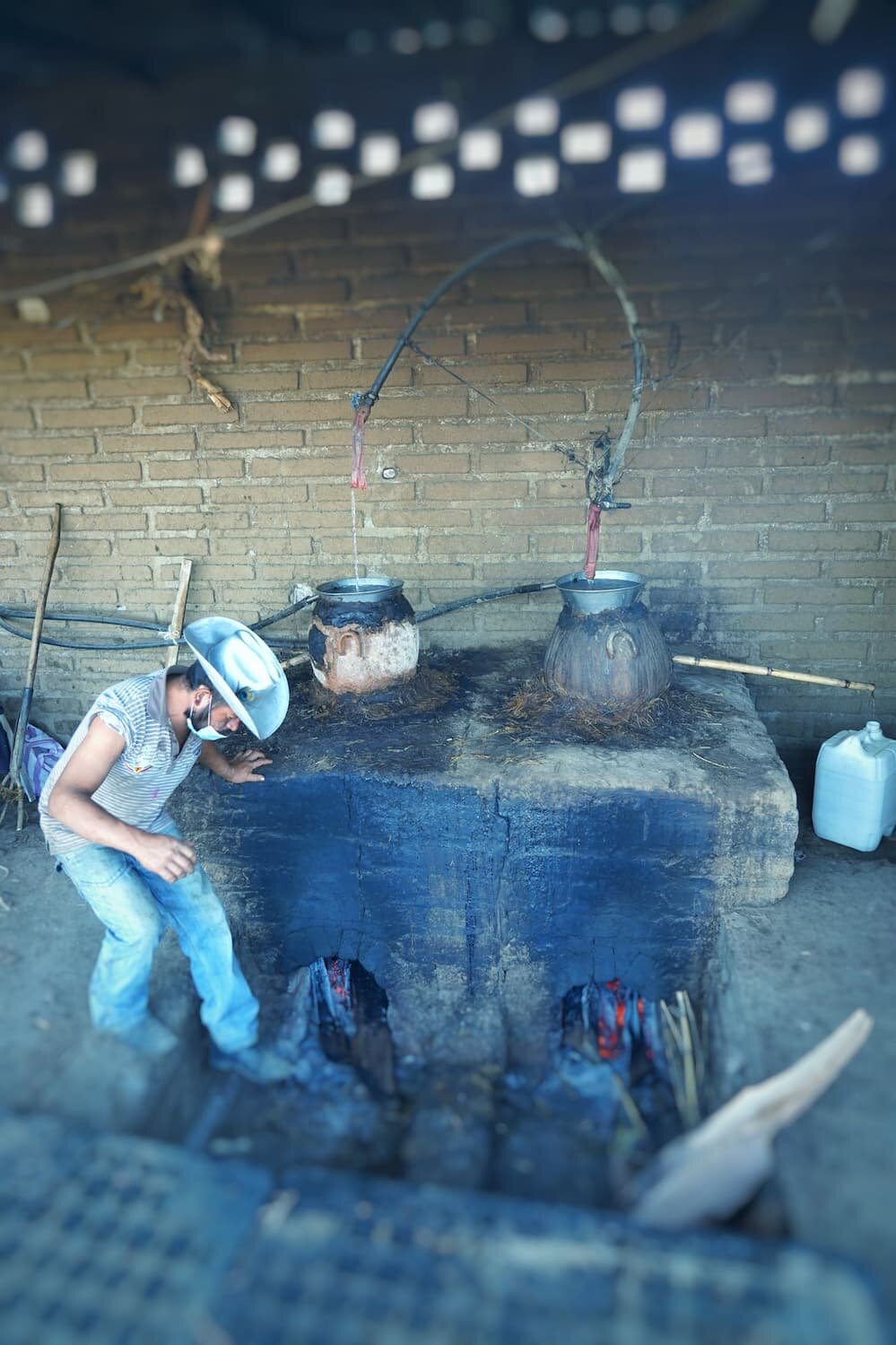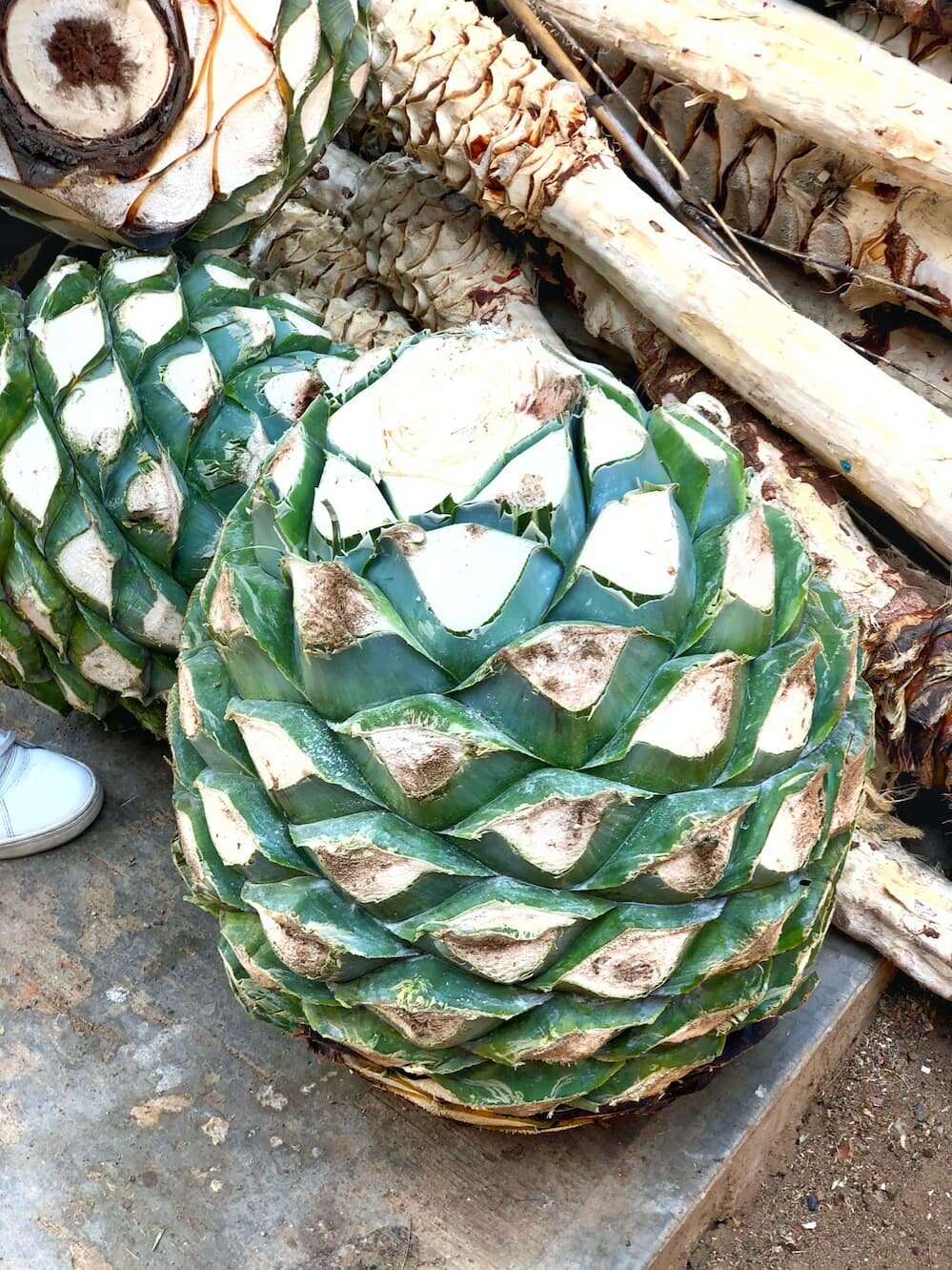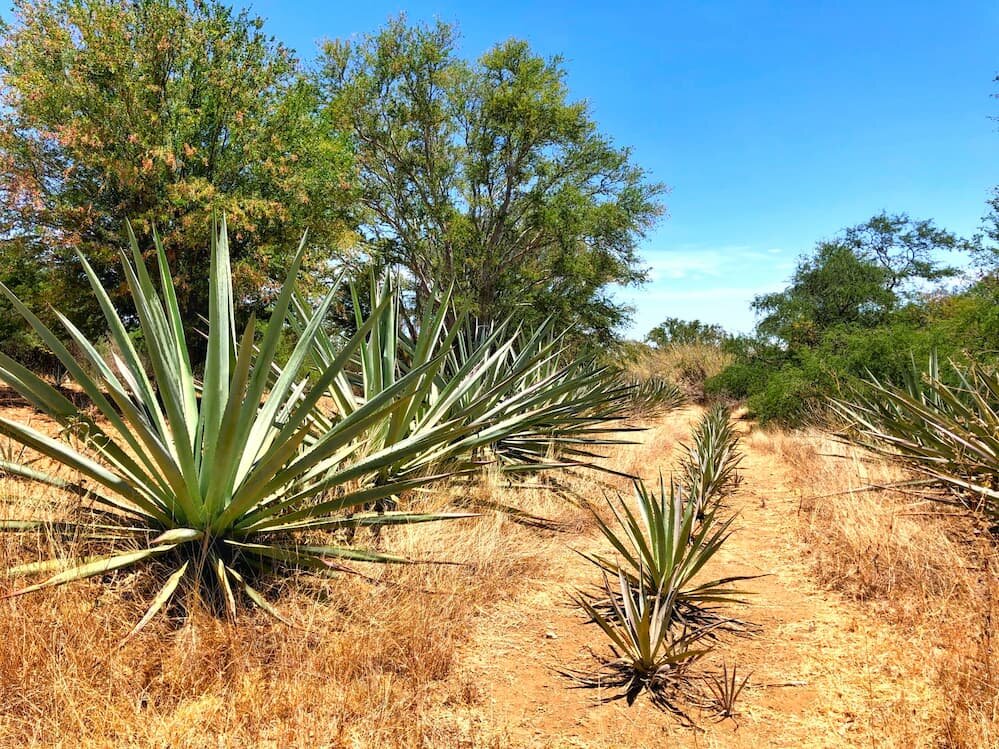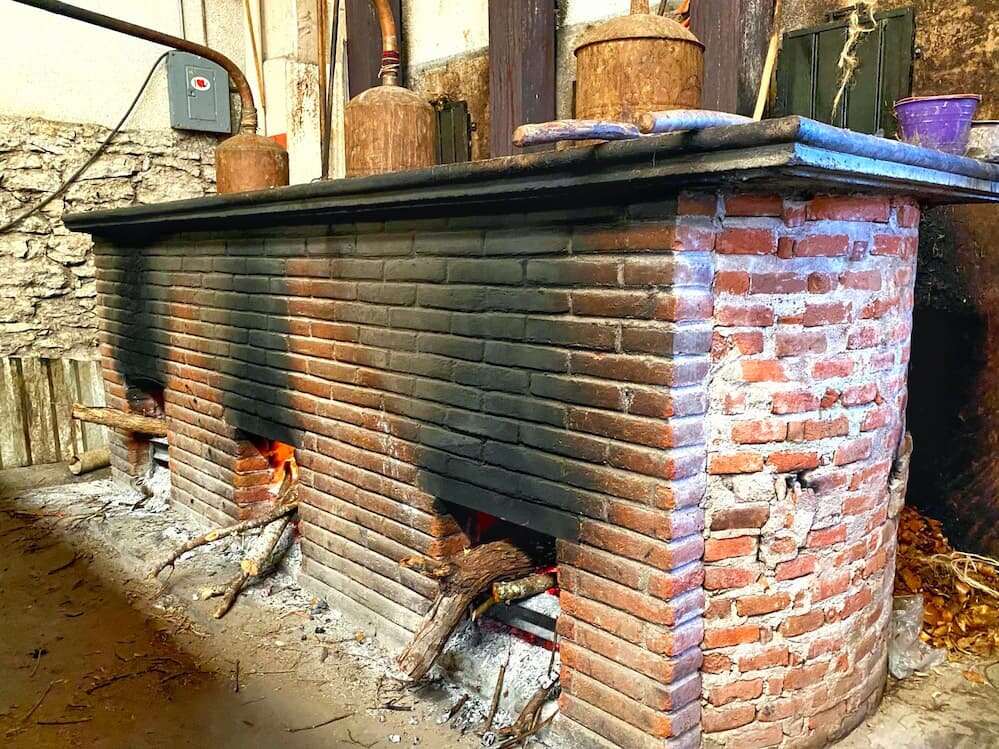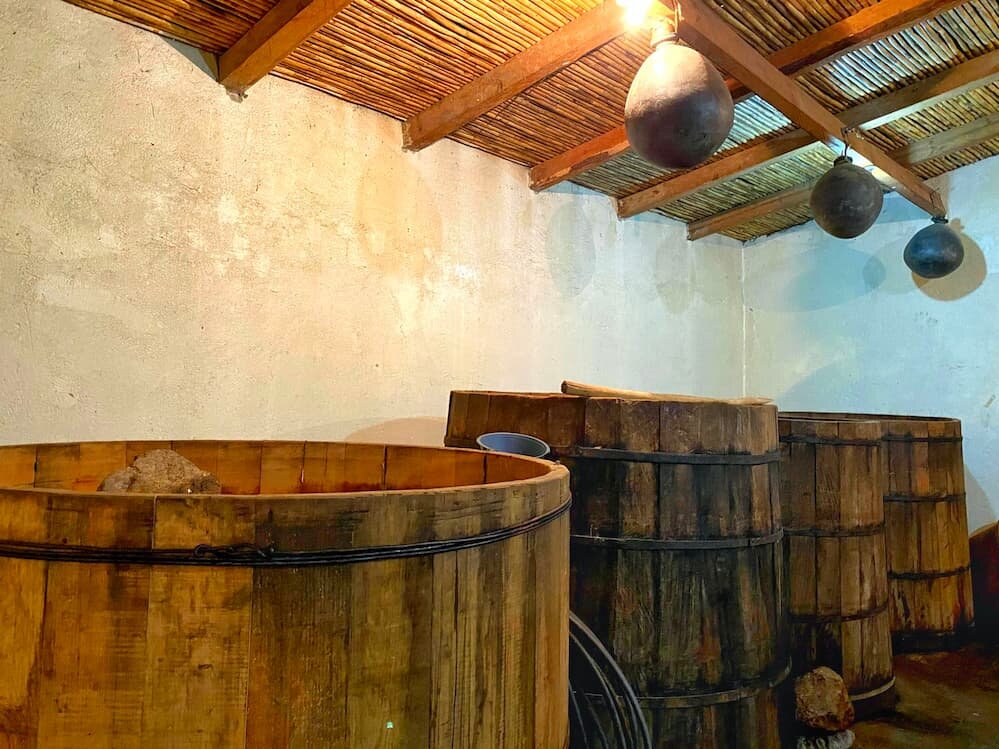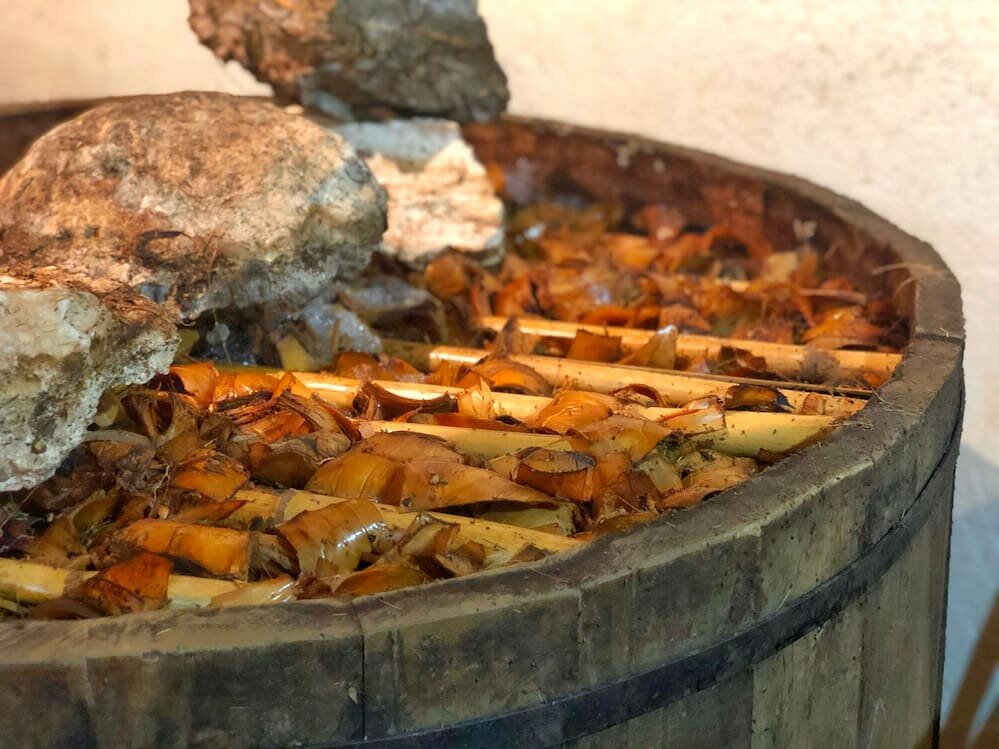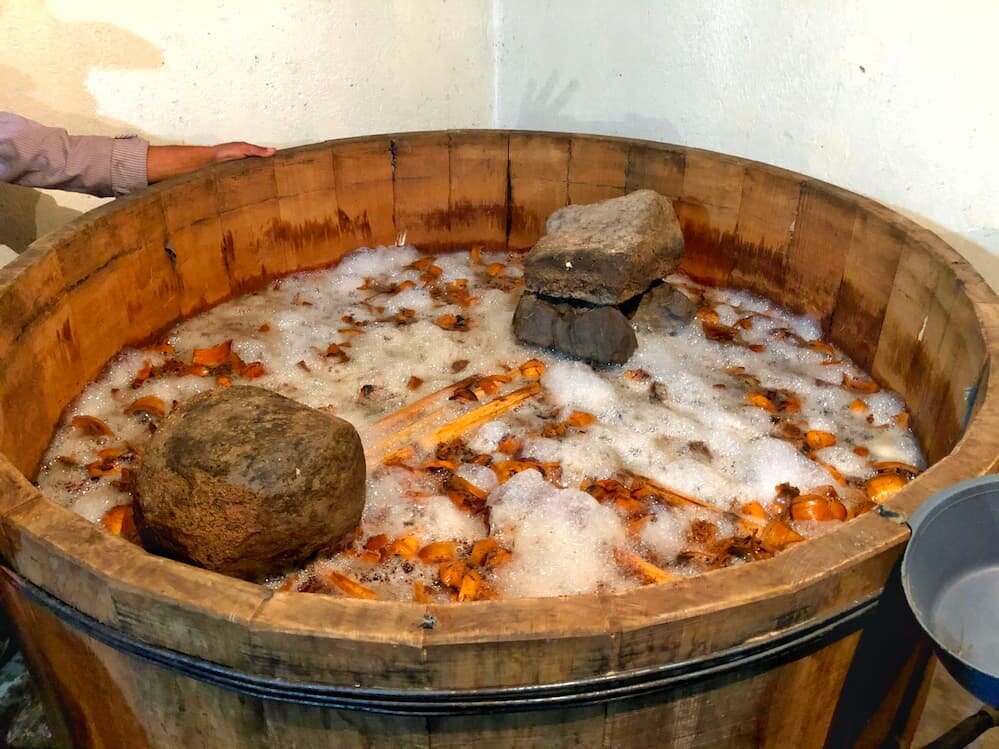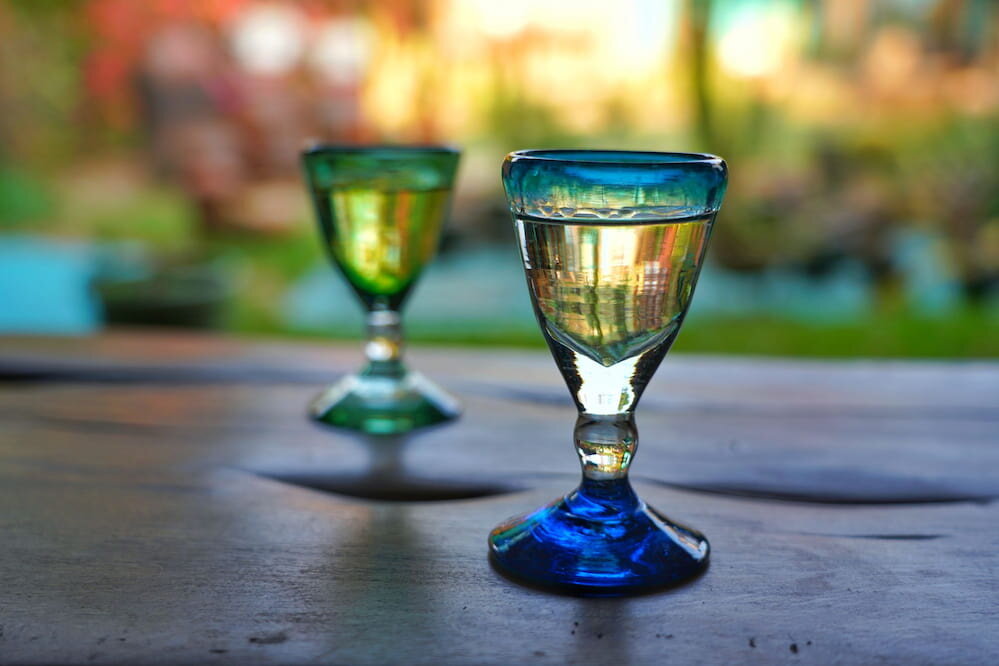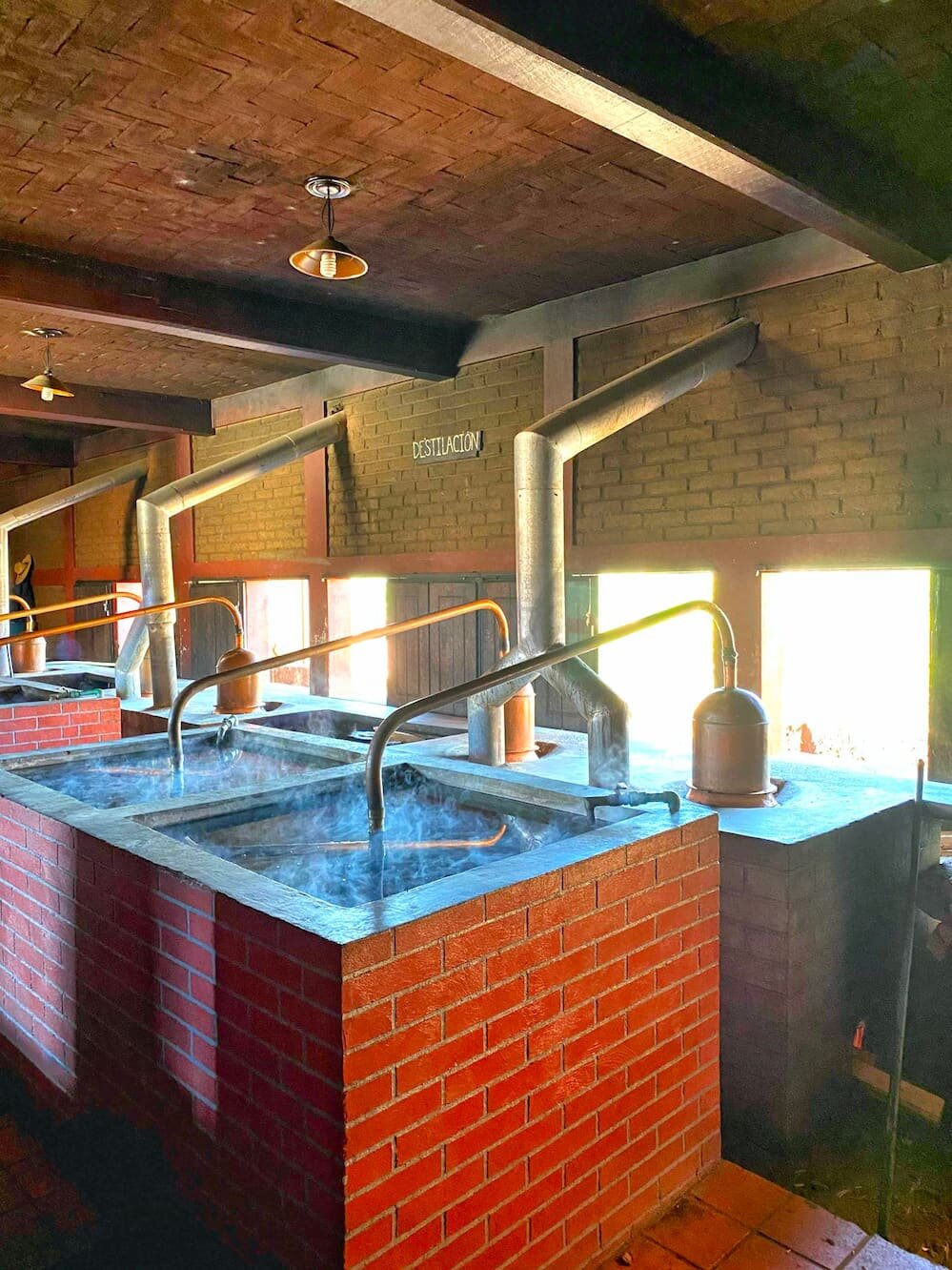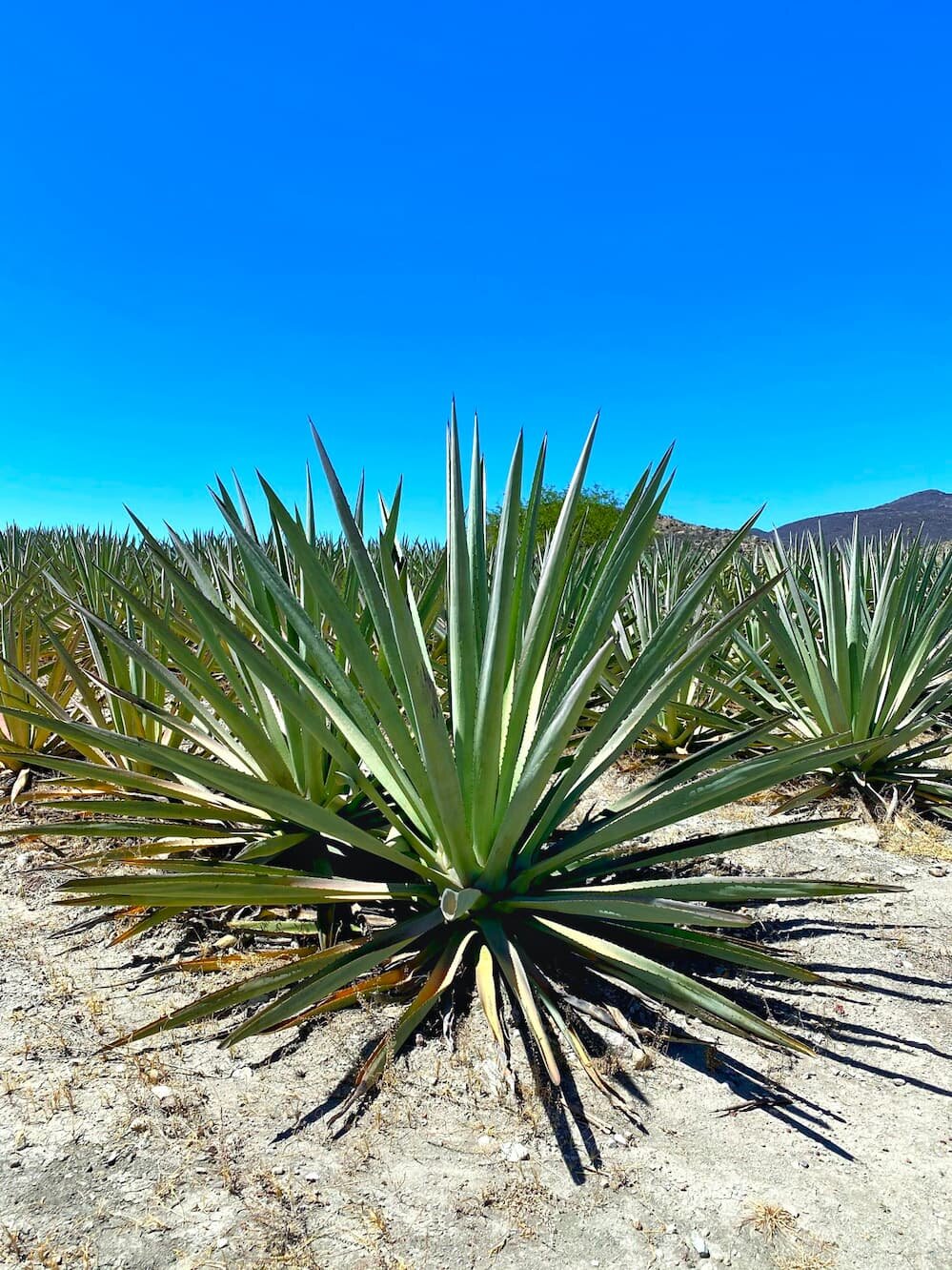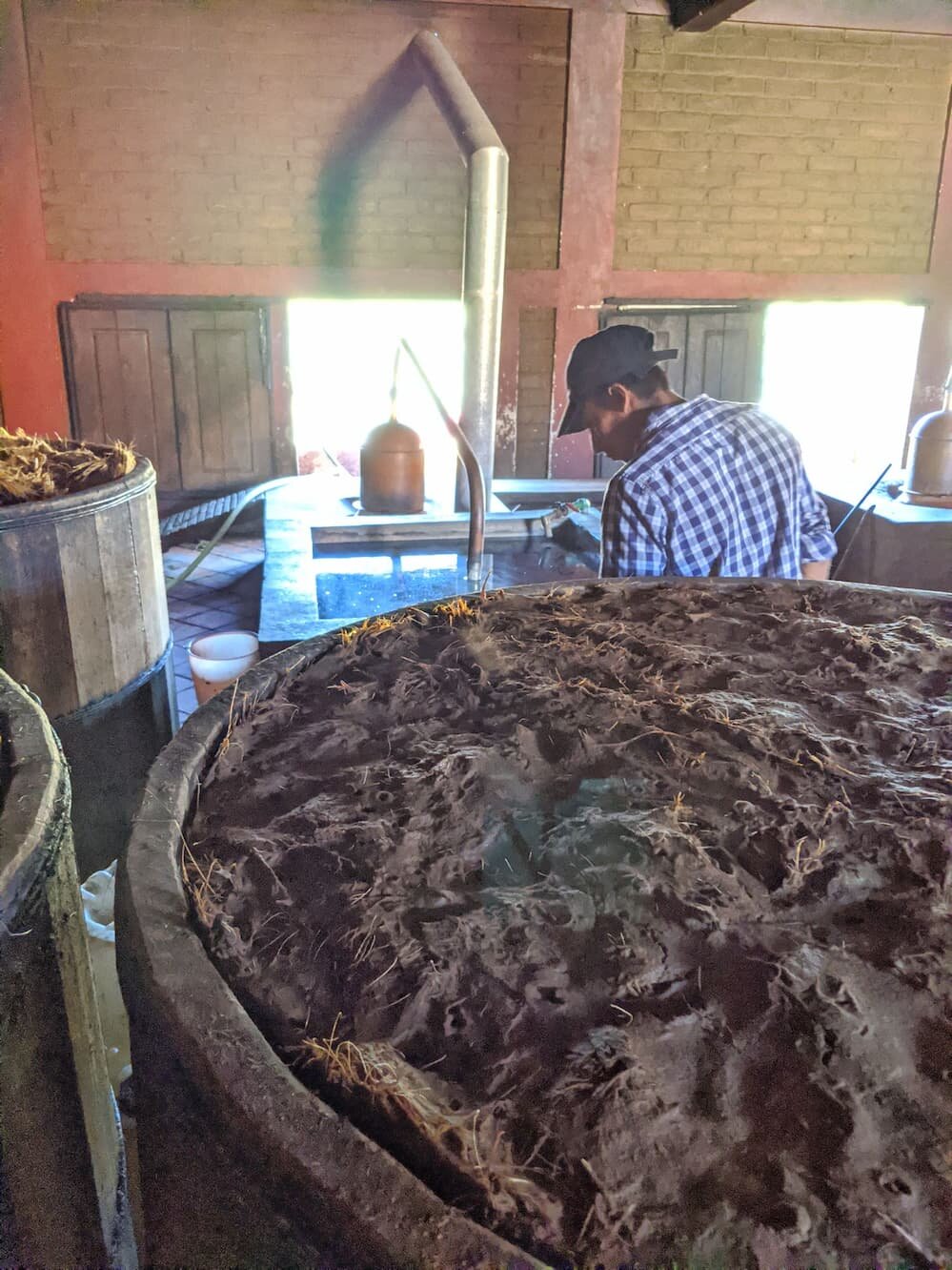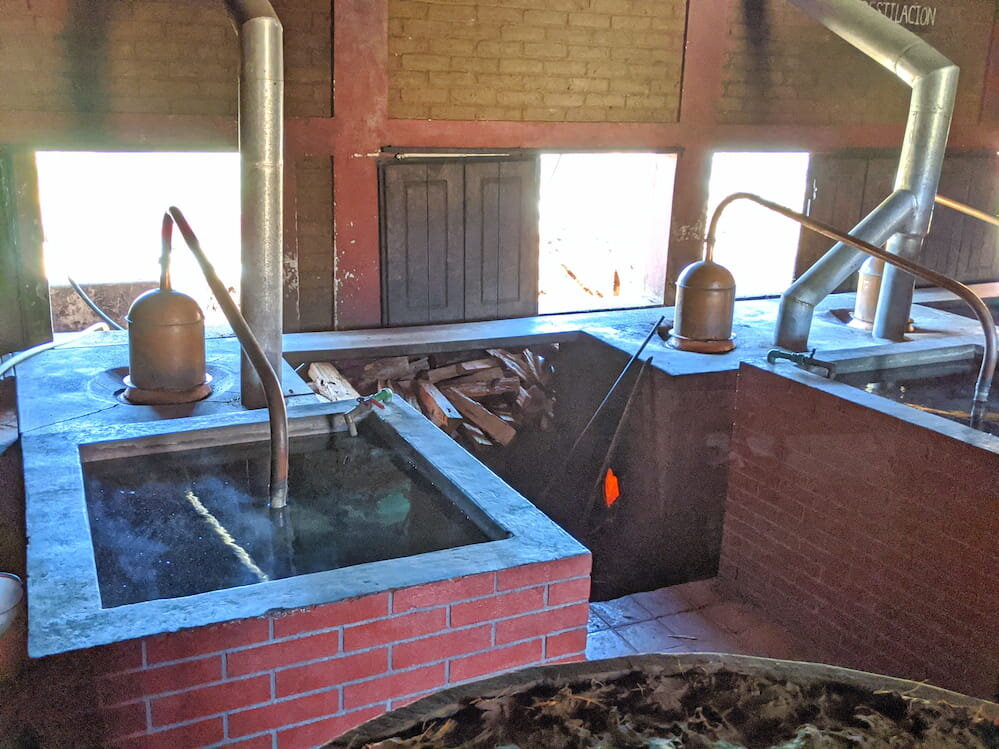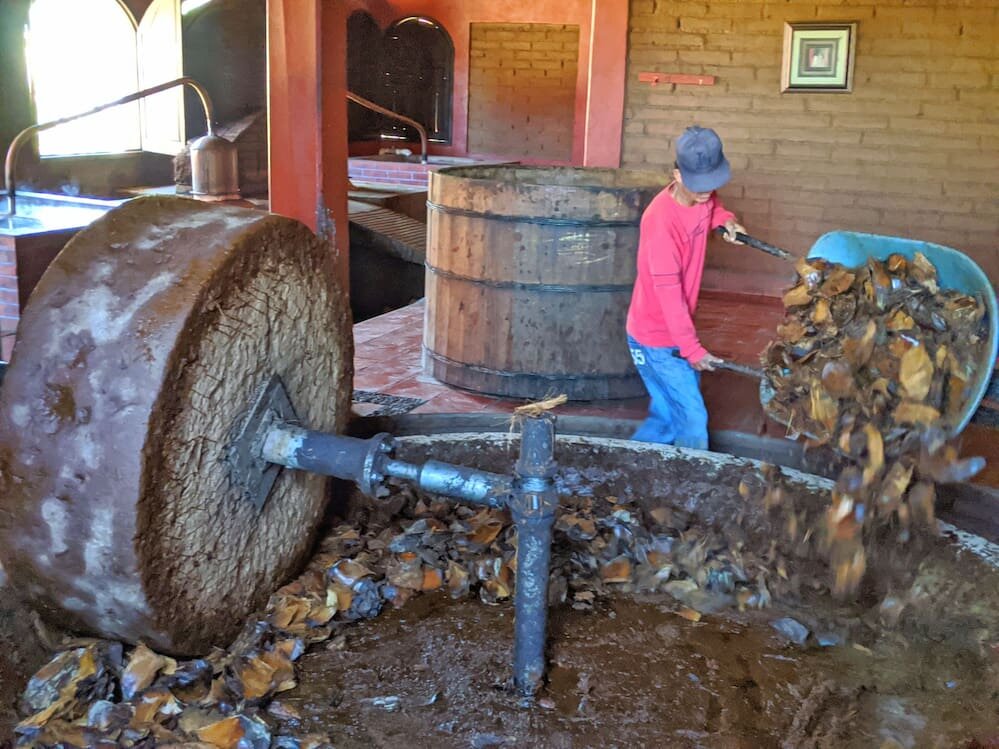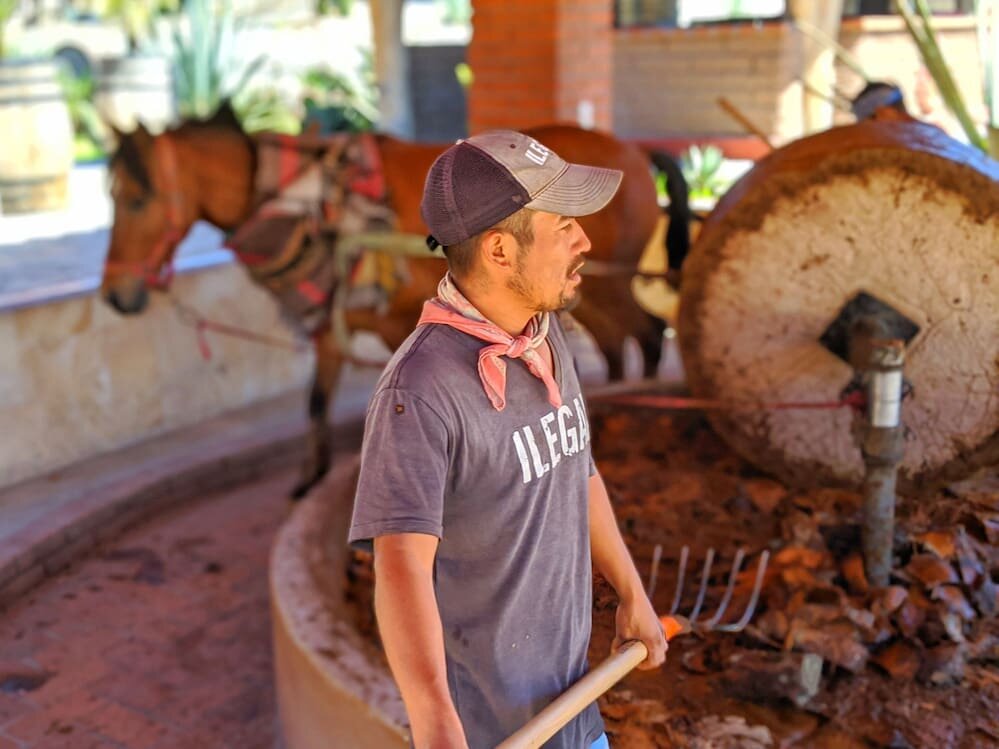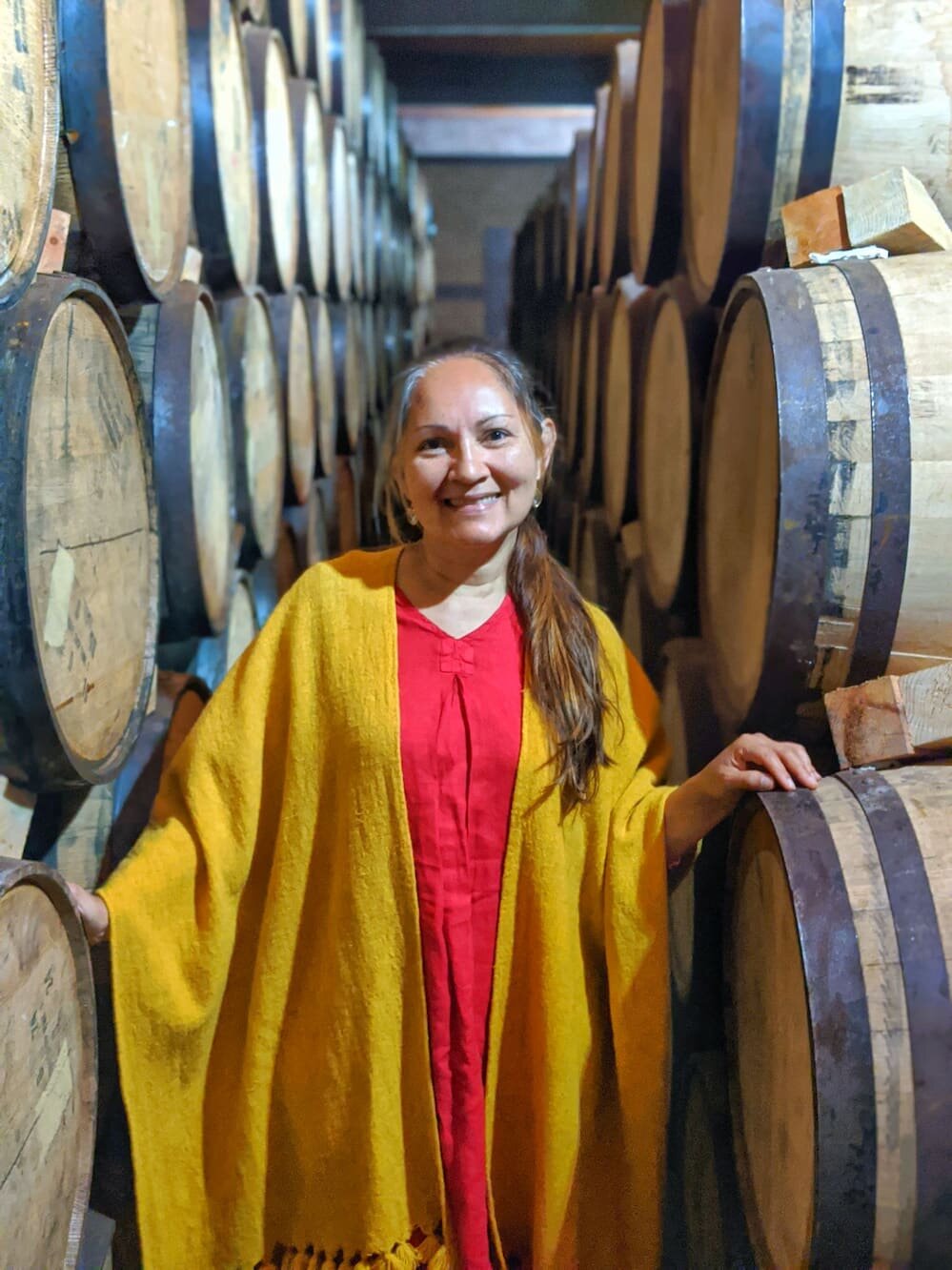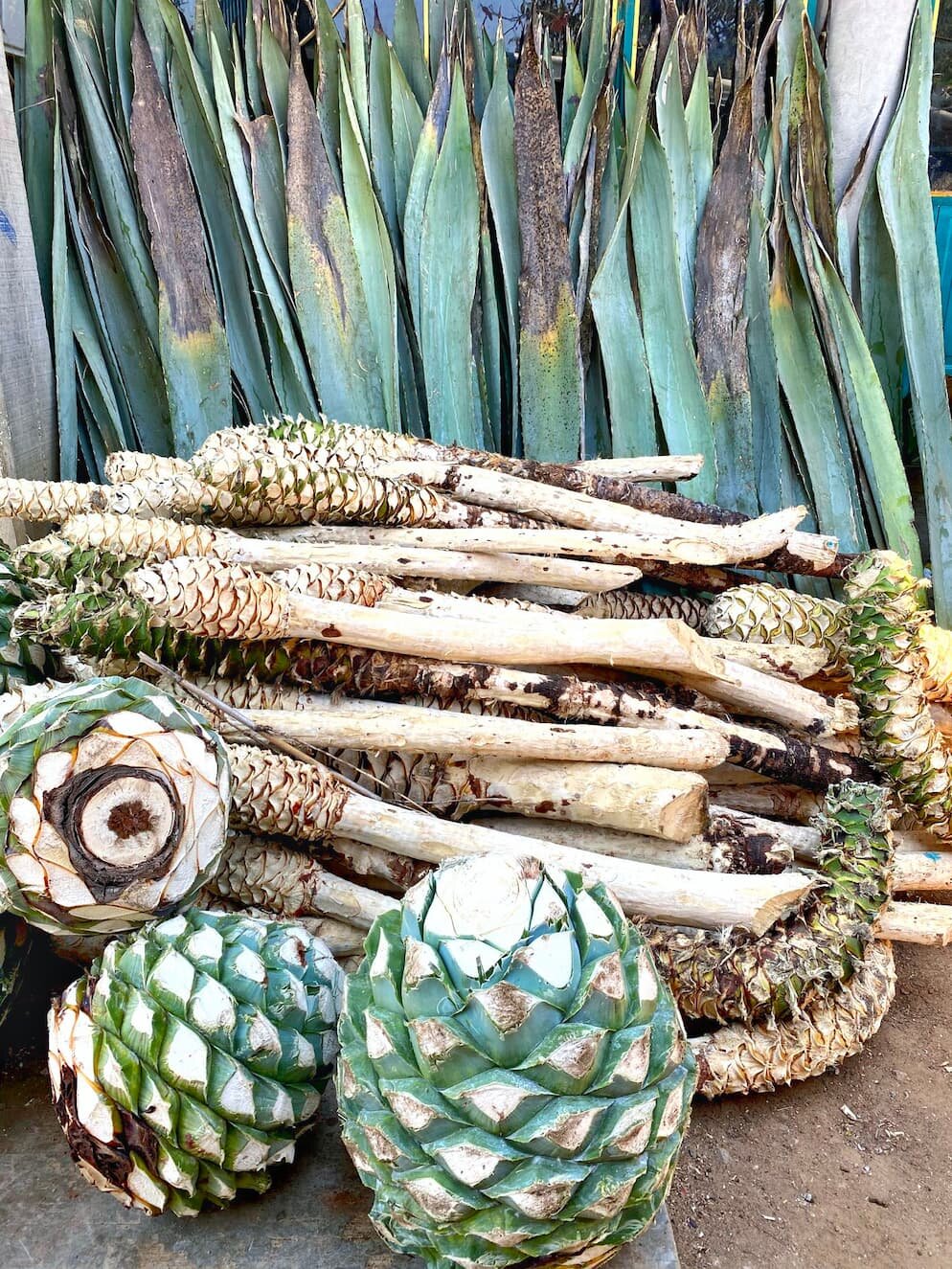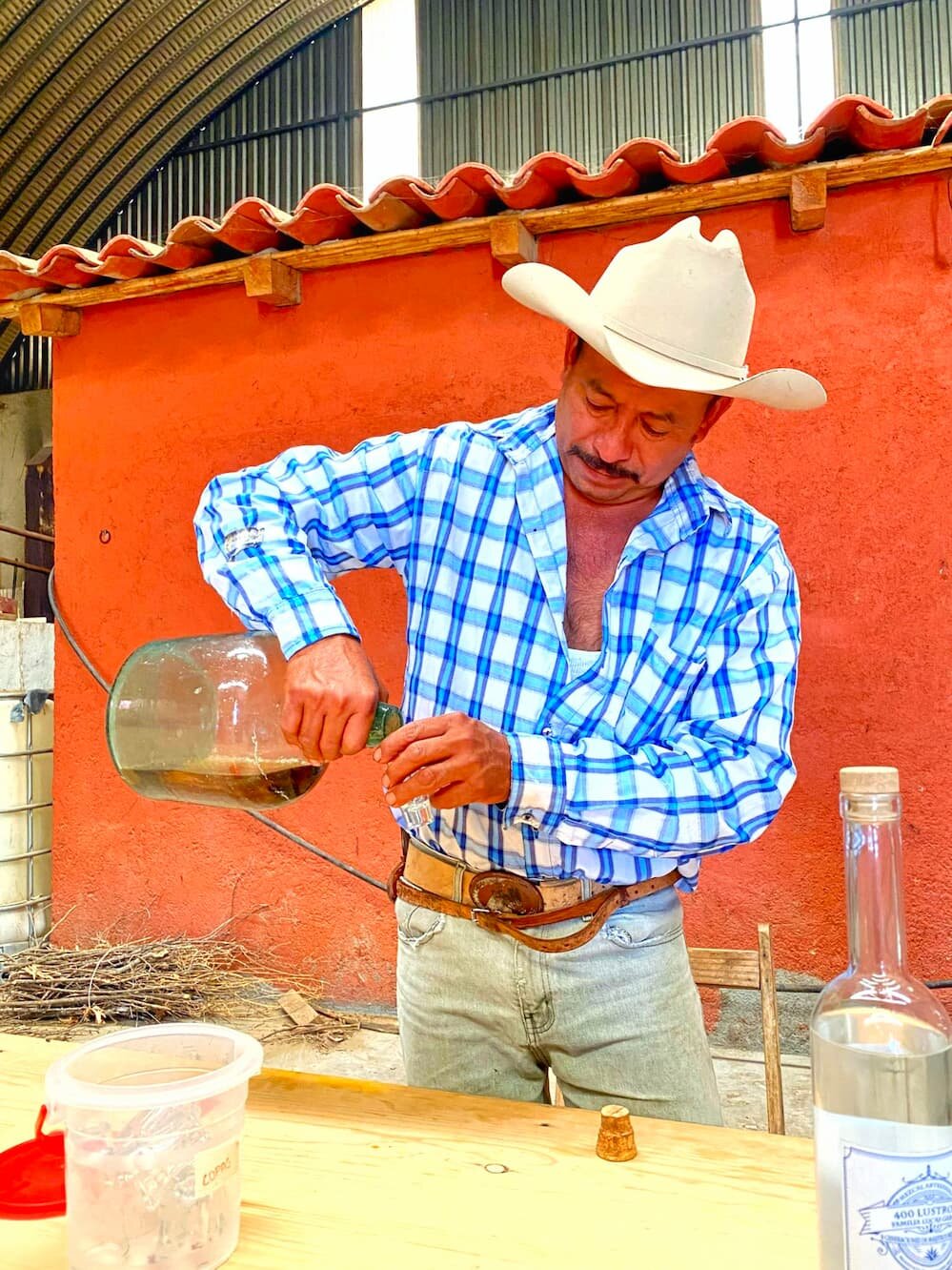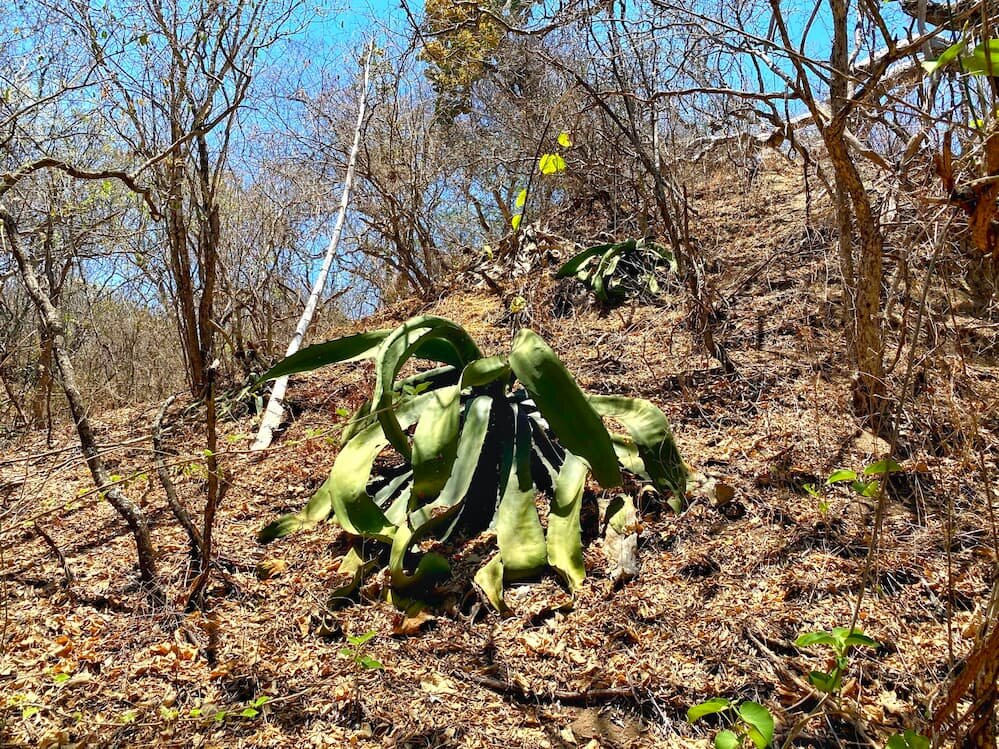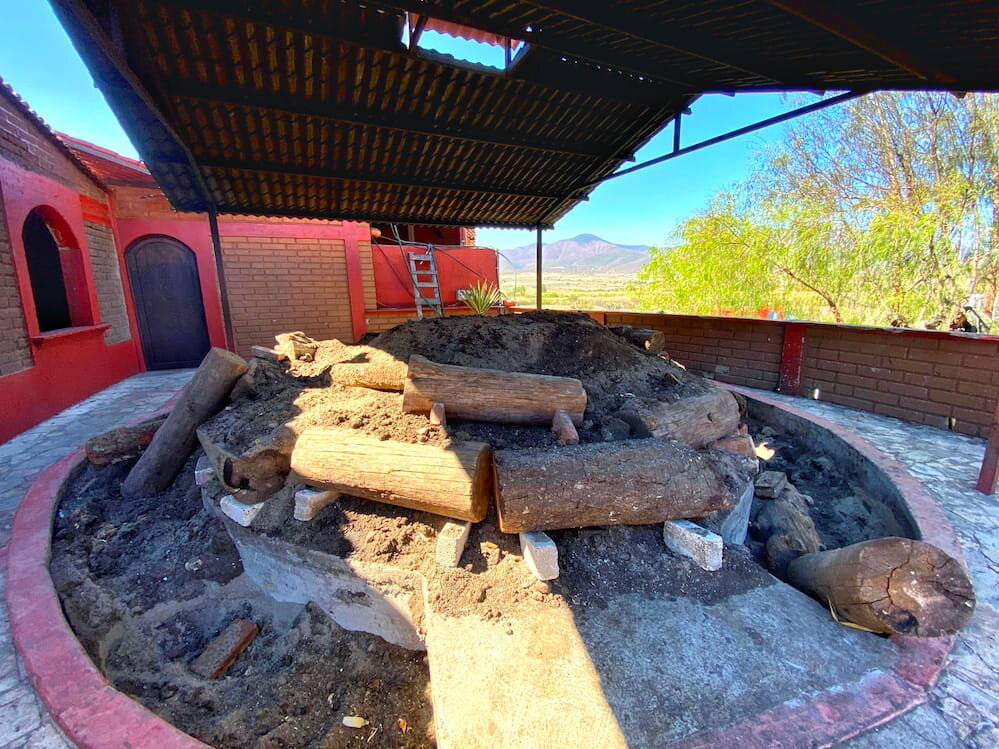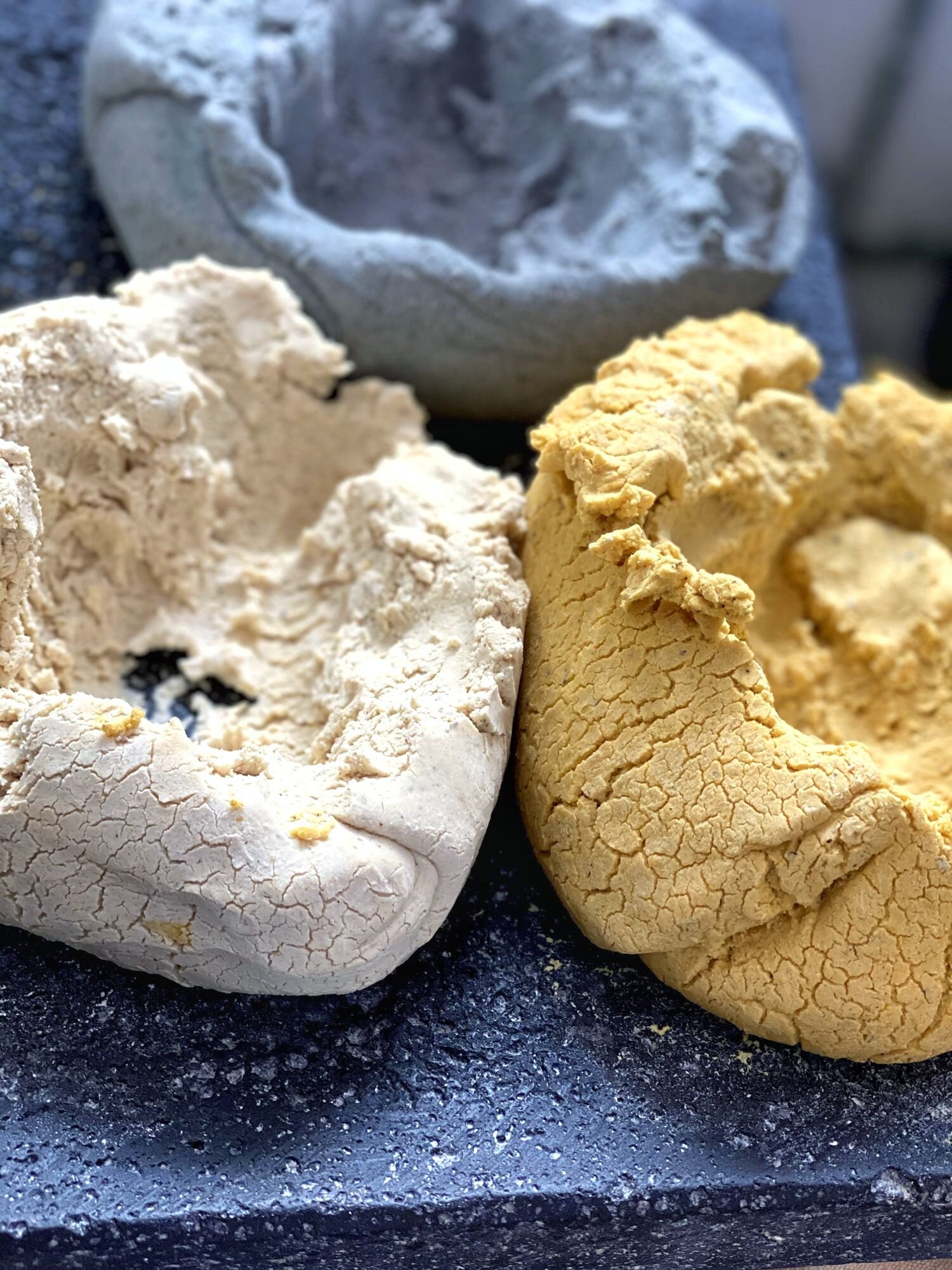The Fez Medina (the ancient city of Fez) is pretty small, but has 9,000 lanes, alleys and walkways that go every which way. Even though we’re super familiar with Fez, getting lost is inevitable. Here I had gone down a hundreds narrow alleys and turns, only to arrive at another dead end.
On the places you won't find in the travel guides
When you’re on a two-week vacation, you need to turn to the travels guides — books, sites, apps, blog posts, social media posts and maps recommendations. But when you’re living abroad as a digital nomad, you have the time to explore, find the stuff that’s not in the guides and try them out.
In this picture, I’m in line for a dive Xochimilco pulqueria (I’m the gringo at the back of the line with the giant backpack). This bar is purely local. And, in fact, it’s unlikely to spot gringos even in the neighborhood.
We love this kind of discovery. And the reason is that once any bar, restaurant or other thing blows up in the travel guide, it changes. It’s great to experience the unchanged places, which authentically cater to locals.
The only way to discover local-only establishments at scale is to spend months and months in a place, wandering around and relying on serendipity.
In the Moroccan Sahara, you can see the stars. All of them!
On our first trip into the Sahara, we traveled from the edge by camel for a few hours into the desert. Our guide, a barefoot Berber, suggested we scamper up a nearby dune to watch the sun set while he made dinner. I thought the food would be horrible, sandy, cold or weird, but it was in fact the most delicious tagine I had ever eaten. The flat disks of bread started out fresh, but were dry as crackers by the end of our meal due to the extreme dryness of the desert, which steals all the moisture from everything.
Our tent was made of camel hair, and was dark olive green. The night was so perfect, we moved our bed outside onto the sand and slept under the stars. The entire sky was stars — there was only bright stars and dim stars and bright galaxies and dim galaxies — so many stars that you couldn’t see any black space between.
The Milky Way was rising as we drifted off to sleep. I woke up hours later, and it was directly overhead, mostly filling the sky. The galaxy felt sometimes like a ceiling just 10 feet over my head and sometimes like a blanket actually covering me.
Here's one for the bucket list
Once in your life, make sure you find yourself in a beautiful wooden boat on the Grand Canal in Venice at sunset. Trust me on this one.
Let's get real in 2022
The last two years have tested everyone’s patience, endurance and forbearance. But if the pandemic has taught us anything, it’s this: Life is short. The world is vast. Being cooped up sucks. And people are precious.
Let’s make 2022 the year we embrace the real and reject the artificial. Let’s turn our backs on fake “friends” on social media and any other social interaction that doesn’t bring us joy. Let’s reject fake, fast and junk food. Let’s spend less time in our concrete jungles and track housing complexes and strip malls.
Let’s give ourselves the gift of what we really need: Real food. Real friends. Nature.
Let’s get real.
The cure for the funk you’re in
Everyone these days is feeling grumpy. Or down. Or some level of frustration. Or a vague combination of all three. It was noticeable enough before. But now even the holiday season isn’t working its usual magic.
The New York Times said: “Millions of Americans Can’t Shake a Gloomy Outlook.”
It’s this damned pandemic. The illness, death and loss has created a sustained sorrow — a second pandemic of poor mental health. The on again, off again mask mandates and lock-downs make everyone feel trapped and uncertain about the future. The new variants. The political acrimony. It’s all just too much to sustain for what will soon be two entire years.
It seems like there’s no escape, no break, from bad news.
And so it’s hard to get inspired, or feel joy.
Or is it?
Amira and I just got back from a week in Oaxaca. (And three days in Mexico City.)
Traveling to Mexico is not unusual for us, even during the pandemic. We’ve been to Oaxaca six times this year. The difference is that we’re normally very busy. But this time we didn’t really do anything except meet with lots of friends, eat a lot and have a ton of fun.
We did some hiking, including some quality time hiking up to the Monte Albán site (ruins of the capital city of the Zapotec empire), and then just hung around among and upon ancient pyramids all day.
We ate some delicious food (including a special chef’s dinner complete with on-premises mezcal distillation and live music).
What we discovered is: This is the cure!
Here’s the specific formula for curing a pandemic funk:
Go to a beautiful place that has great food
Let go of all structure — no bedtime, no calls, no work
Immerse yourself in the place and forget about home for a time
Hang out with people who are positive and supportive
Get some exercise and sunshine and spend time in nature
Don’t check the news or social media — do a digital detox
Avoid tourist services, hotels and conventional activities
Listen to music, dance, eat and forget about the world and all your troubles!
The reason this works is that you’re removing yourself from your everyday life, letting go of all the problems and sadness in the world and re-acquainting yourself with care-free fun and the joy of food, drink and friends.
Yes, this is the Gastronomad way to travel, and it’s something that happens during our Gastronomad Experiences. Even more so, because during an Experience our guests make no decisions at all, which is yet another way to take a break for people who make too many decisions every day.
But whether you join a Gastronomad Experience or not, it’s time to use our 8-point formula to break that pandemic funk you’re in.
Joy to the world! -Mike
A glorious and surreal return to Italy
We just spent a few weeks in Italy after two years away. It was glorious. And surreal.
We spent time in Venice and the Veneto region visiting old friends and meeting new ones, exchanging stories of loss, pain, devastation, survival and the silver linings we all found in the clouds.
Wandering aimlessly through the labyrinthine alleys and canals of Venice without the normal throngs of foreign tourists was like going back in time. The canals still looked pretty clean and the nights were quiet — a rare, probably once-in-a-lifetime experience.
But it didn’t last. By the time we left weeks later, Venice got crowded again with visitors from all over the world. The spike was driven both by easing or clarified travel restrictions, plus the one-two punch of a Dolce Gabbana fashion show and Venice Cinema Week.
Venice was extra festive and interesting with all the fashion and film goings-on, which attracted all kinds of celebrities, including Jennifer Lopez and Ben Affleck. It felt like Venice was on the cusp of returning to its normal hustle and bustle of pre-pandemic times.
Venice was so crowded, we wore masks even outdoors in the narrow streets.
After hosting The Prosecco Experience, which just ended a week ago Saturday, we’re feeling restored, inspired and filled with hope.
More than ever, we are proud to say that The Gastronomad Experience is not only the most joyful way to travel, but also far safer than traveling on your own — with or without a pandemic.
Covid tested our resilience and turned what would have been our best year into our worst. We have mourned the loss of people and have shared the sadness of friends whose marriages ended during the stress of a horribly painful pandemic. Restaurants, bakeries and cafes we used to love have permanently gone out of business. Prices for everything have gone up, making travel more expensive than ever before.
Still, though we’re all still facing a world fractured by a devastating pandemic, it’s important to celebrate every small victory, and life itself. And there’s nothing that brings more lasting joy and happiness than sojourning in faraway lands, exploring other landscapes and eating and drinking local foods and wine.
Joy and gratitude are the best antidotes for pain and suffering and something we can all cultivate. Exploring the world, learning from other cultures, tasting local cuisines and wine at their place of origin with locals while enjoying breathtaking views in the world’s most beautiful places is good medicine for the soul. It’s what nourishes our curious minds and our wandering souls.
Above all, it’s the people who sign up for Gastronomad Experiences that renew our spirits. These are formidable people with open minds and open hearts. They trust us despite, the limited information we share about the Experience to come. (Our activities remain secret so we can surprise you every day.)
Our trip to Italy was poignant and surreal, but on balance filled with joy, hope and the happiness that always comes from great food, amazing wine, stunning landscapes and, above all, love and friendship around a table.
Wow! The scenery in the Prosecco Hills!
The Prosecco Experience isn’t just about incredible Venetian food and some of Italy’s best wine. These culinary delights take place against a backdrop of pristine rolling hills covered by cascading vineyards, hilltop villages, ancient farmhouses and heavenly skies. Only two spots left for The Prosecco Experience in May, 2022. You deserve this.
A rainy morning in Venice
Venice is famous for, among other things, its throngs of tourists and seasonal flooding. But Venice is so nice in the early morning when nobody is around, and during a rain when the sea level is behaving.
Crispy egg… apparently?
Landed in Venice, showered and made haste to a very good restaurant called Ai Mercanti up meet up with friends. Couldn’t help but notice that they’re serving what are “apparently” crispy eggs. Don’t they know?
Spain becomes the best place in Europe for digital nomads
Remote old villages. Digital nomads. They were made for each other.
The villages need people who spend money without taking a local job. The nomads need a beautiful, quiet place to work, live and experience what it’s like to live in a traditional setting.
That’s why some 30 villages in Spain — each with fewer than 5,000 residents — formed an organization called the “National Network of Welcoming Villages for Remote workers.”
Communities across Europe have embraced the digital nomad movement, especially in Italy. But Spain’s program is different.
The site is similar to AirBnB, showing how many guest houses are available in each town, and enabling nomads to book a place.
The Spanish program offers up a local resident host to serve as a liaison for nomads, connecting them with life in the town.
This program gets at the heart of the digital nomad and Gastronomad lifestyle. You can forget the mobs of tourists in Barcelona. Instead, visit the real Spain where locals will greet you with open arms.
The organization is totally compatible with a new “Startups Law” that enables digital nomads to stay and work in Spain for up to two years at a time.
Suddenly, Spain moves to the front of the line as a great place for digital nomads to temporarily live.
This flight search website gives you the covid rules for arrival
This is the flight-search site and app we need right now: Escape enables you to check out all flight options, including times and fares, so you can choose where and when to go. Best of all, a new feature gives you the covid rules — whether you need to prove vaccination or not, etc. — so you can factor that into your choice.
Remote workers need workations, too!
It's a great idea to unplug completely from work sometimes, remove yourself from home and reboot your mind. (This is an excerpt from our Gastronomad newsletter.)
Everyone knows vacations are good, healthy and necessary.
So why are workations so controversial?
A workcation is like a vacation, but with two differences: 1) you're working the whole time; and 2) you're not taking time off — those days are counted as work days, not vacation days.
The workation concept triggers a general contempt on social media. An extremely non-scientific, non-representative poll on my Twitter account showed that fewer than one-third love the idea and the rest either hate it or aren't sure.
Workation is a slang neologism in existence for more than 150 years. It came into popular use especially in the 40s, and again in the late 70s and early 80s, returning now in a post-pandemic, remote work, digital nomad context.
In the past, workation meant working while you were supposed to be vacationing. Now it means working in a place and context of a vacation, but actually working and getting paid to work. In other words, it used to mean working while you were supposed to be vacationing. But now it means working while you’re supposed to be working, but in a nice place.
There's a big difference: In the old meaning, you were using your time off to work without pay. In the new meaning, it means you're living temporarily as a digital nomad — getting your normal pay, not using vacation days and simply moving your “office” to the location of your choice.
As I explained in my book, Gastronomad:
"Years ago, while living on the Greek island of Crete, I discovered a really nice restaurant with an amazing view of the sea. So I decided to eat, drink some coffee and work there for the rest of the afternoon. After a while, I struck up a conversation with a couple at a table nearby. They were Germans on holiday and confessed that they assumed I was one of those workaholic Americans they heard about who can’t even take time off during a vacation. There I was in this beautiful place, slaving away. Pathetic!
But then I explained: I wasn’t on vacation at all. That day was an ordinary work day for me.
It’s not that I’m bad at taking vacations. I’m just good at choosing an office."
That's the key fact about workations. It's not about what you do during your vacation — you still get your normal vacation time. It's about what you do while you're working.
The covid pandemic drove a new wave of remote work, which for most means working in a home office instead of an office office.
I'm here to tell you that not only do remote, home-office workers need vacations, they also need workations — and are in a better position to take them.
It's psychologically unhealthy for many people to live and work in the same house and rarely leave — or just leave once or twice a year only for their paid vacations.
While on workation, you're spending your work hours in a new and presumably better environment, with new and better food, new and better weather. After hours, during weekends and other time off, you're on vacation. Close your laptop, and the mini vacation begins.
Even during the workday, you can take a 20 minute break and jump in the sea.
This picture is me on a workation in Monterosso, Italy — one of the five villages that make up the Cinque Terre. It was a regular work day for me. Except Italian food for breakfast, lunch and dinner; Italian coffee; a sunny beautiful location to work at; dips in the Mediterranean every couple of hours; and a full-blown vacation after hours and on the weekends.
A workation is more like work when it comes to getting paid. But it's more like a vacation when it comes to your state of mind.
Many employees who couldn't take workations before because their boss demanded butts in chairs at work now can because of the new acceptability of remote work. Nearly everyone with permission to work remotely can take workations whenever they choose.
One silver lining of this awful pandemic is the remote work trend. Take full advantage by experimenting with a workation. Who knows? You just might like it so much you'll want to sell your house and do it full time. - Mike
AirBnB's new speed test feature is nice, but not enough
Airbnb announced today a new feature that enables guests to see an actual speed test for hosts’ WiFi connections before booking.
AirBnB’s move is a recognition of the trends of workations, digital nomad living and the rise in the importance of online digital content and resources, as well as the centrality of video calls for business communication.
AirBnB added M-Lab-based software to its mobile app that speed tests the host’s WiFi network, then displays that result on their listings page.
There are two benefits: 1) All hosts are now using the same speed test system, so the results are comparable; and 2) an actual result stops hosts from exaggerating, rounding up or flat-out lying about connection speeds.
Nice, but not enough. The system still can and will be gamed. In fact, the new speed tests actually helps unscrupulous hosts game the system. Here’s why:
First, AirBnB WiFi routers often have the best performance in places that guests cannot access or cannot actually do work — but hosts can test from those best-in-house locations. This is especially true in countries in Europe, North Africa and Latin America with ancient buildings that have thick walls through which WiFi cannot penetrate. The difference in old buildings between the best and worst WiFi spots is huge.
Second, WiFi performance and internet performance varies wildly depending on local congestion. In some locations, even where hosts have fiber-optic connections, connections become unusably slow at peak hours, forcing users to wait for five minutes to load a simple web page. This happened to me recently in Paris in an apartment with fiber.
What’s going to happen now is that hosts will test WiFi in places that guests cannot access and at times that won’t always coincide with guests’ business hours when they need a good connection.
AirBnB’s system will enable hosts to “prove” they offered a great connection when guests complain that the connection sucked.
What’s needed now is an upgrade that tests WiFi speeds every hour and posts the results of 24 hours, and also a system that measures in every guest work space (not sure how to verify this, but I’m sure it can be done).
This new website tells you which countries have the best digital nomad visas
It's called Nomad Visa, and if they keep it updated it will be a great recourse because the visa and entry requirements are changing fast.
So many new places to discover in Provence
No matter how many times we live in Provence, we still aways discover new and wonderful places. Like this village of Le Barroux, which is old and beautiful and a still-active community. A family still lives in the castle and, if you look closely, you can see them having dinner on their balcony.
(Don’t worry: They were very much in public — you can see them from half the town, and the drone was impossible to see or hear from the altitude I was flying at.)
A Postcard From Post-Pandemic Provence
Greetings from Provence! We couldn't wait to return to Europe. So we didn't wait. (This post is an excerpt from our free email newsletter.)
We landed in Spain early in the morning on the first day Spain allowed vaccinated Americans without pandemic restrictions. And then we flew to France early in the morning two days later on the first day France welcomed vaccinated Americans.
Anti-covid restrictions were and are still in place in both Spain and France. And the practical effect of Spain's rules resulted in needless futility. Indoor restaurants and bars were open, and a general mask mandate allowed for no mask while eating or drinking. That all sounds reasonable, but in practice it meant that in Spain, everyone suffered mask wearing outdoors in the heat where a mask is pointless. But as soon as anyone sat down indoors, the masks would come off. And so everyone wore masks when they didn't need to (outdoors), but did not wear them when they would have been effective (indoors).
In France we noticed that nobody was eating indoors, but the outdoor restaurants were booming.
France's response to the pandemic was different from most countries. They used restrictions on distance — for example, dog owners were allowed to leave their homes to walk the dog, but were not allowed to walk beyond one kilometer from their home (a little over half a mile). They also used curfews.
At the beginning of the year, the curfew started at 6pm, which changed to 7pm in March. The significance of this is that the French normally eat dinner after 7pm and in Paris, often times after 10pm. So the regular schedule of dining out was seriously disrupted in this restaurant-loving nation.
When we arrived in Paris, the curfew was 9pm, and within a couple of days it was extended to 11pm. In other words, normal restaurant dining was back! The elation of locals was palpable, and we felt so privileged to join them in their elation.
A few days before our Provence Experience began, France stopped requiring outdoor mask wearing.
Tourists from English-speaking countries have been allowed in France for three weeks, but even now there are almost none. In Paris and Provence, you hear French almost exclusively. In sweet Provencal towns, like l'Isle Sur la Sorgue, where we are currently living, visitors from nearby towns flood the streets, cafes and markets on weekends. But foreigners are rare or nonexistent.
All our French friends and other locals that we meet tell us how happy they are to see American visitors again, and for three reasons. First, Americans are the world's best tippers. At restaurants, Americans tend to order more expensive items than average, then tip a high percentage on that purchase. Because French law dictates a 15% service charge to be added to every restaurant bill, French diners often don't tip at all. If they do, they might tip 5% and never more than 10%. Americans usually tip between 15% and 20% on top of the service charge. Both, restaurant and waiter make bank on yanks.
Second, Americans are vocally appreciative. Americans love France, French food, French wines, French landscapes and French buildings and towns, and aren't shy about saying so. Smiles and effusive praise are cultural norms for Americans.
And third, Americans are large in number — by far and typically the biggest group of visitors to France from outside of Europe. When there's no pandemic, American visitors to France number well over three million, which represents around one third of the total visitors from outside Europe.
France's economy is heavily dependent on tourism, and that's especially true of the Provence-Alpes-Côte d'Azur region, which includes both the Provencal countryside and the French Riviera.
When the pandemic hit, restaurants, hotels, wineries and other such businesses took a massive hit and barely survived.
For French providers to see members of that big, loud, appreciative, generous-spending nation back in town is a symbol of a return to normal.
Another universal we discovered is a wider language barrier. All our English-speaking friends have substantially regressed in their ability to speak English. And our French has suffered, too.
Above all, here in France, the joy of freedom, the joy of gathering, the joy of sitting at a table with good food and conversation is almost overwhelming. We felt that joy every day during our Provence Experience.
What an amazing time to be in France!
And, finally: Happy 4th of July, Americans!
Inside the Magical World of Mezcal
Do you know what mezcal tastes like?
Mezcal is a distilled beverage made from cooked and fermented agave juice. But that definition barely scratches the surface of this incredibly complex spirit.
Most people outside Mexico are more familiar with tequila, which is in fact one kind of mezcal. All tequila is made from agave tequilana Weber, or Weber blue agave and cooked in steam ovens, usually in the state of Jalisco.
Mezcal, on the other hand, can be made from any of roughly 50 species of agave, and each brings a different taste to the final product.
Mezcal agave species have names like Tobalá, Americana, Durangensis and many others.
One of our favorite species is Agave Karwinskii, which is grown mainly in Oaxaca, and which comes in varieties called Cuishe, Baicuishe, Madre Cuishe, Barril, Tobaziche and Verde, each variety offering differences in taste (but all very good).
One way to look at the difference between tequila and mezcal is that tequila is simple and mezcal is complex. Tequila is relatively simple, because it's made with one agave type and one production method. Mezcal is complex because it's made from many agave types, many production methods, many variations on flavors and (like tequila) also has variety introduced through aging.
The word mezcal is a bastardization of the Nahuatl word "mexcalli," which means "baked agave."
Mezcal is made in the Mexican states of Durango, Guanajuato, Guerrero, San Luis Potosí, Tamaulipas, Zacatecas, Michoacán, and Puebla. But most mezcal is made in the state of Oaxaca.
Artisanal and traditional mezcal making is very much a phenomenon of Oaxaca. Of Mexico's 625 mezcal production facilities, 570 of them are in Oaxaca, producing 90% of the country's mezcal.
How Mezcal is brought to life
Mezcal is made from agave at the end of the plant's life.
Most agave plants are harvested after roughly 10 years, although some can grow for 30 years before harvesting, depending on the agave species. Most mezcals are made with farmed agave. But some are made with wild agave, and these have distinct flavor differences from their domesticated cousins.
When most agave species ripen, they bloom by quickly growing a single flower stalk up to 15 feet high, a process that, if allowed to occur, enables the plant to seed before dying, but the flowering spoils the piña for agave making. Mezcal growers chop this stalk off to preserve the piña until they can harvest it.
They chop the spikey leaves off with a machete, then hack and shovel the "piña" at the base to remove it from the roots. This piña is sometimes roundish, sometimes elongated, depending on the variety of agave.
The piñas are cooked for a few days, often in underground pits. Underground baking causes the smokey taste in most mezcals. They can also be cooked with steam ovens in the same way tequila is cooked.
The cooked piñas are then mashed, sometimes with a stone wheel pulled by a horse, and then fermented with water in wood barrels or vats.
The fermented liquid is then distilled, usually twice — sometimes thrice — in copper or clay pots. (Ancestral distillation happens in clay pots and wood pipes.)
After distillation
The reason mezcal is available in such breathtaking variety is that so many factors contribute to the taste: The species of agave, the cooking method, the fermentation time, the distillation process, the aging process, and also things added to affect the flavor. These can include fruits, herbs, spices, chicken, turkey or duck.
Mezcal flavored with poultry happens either during steam cooking or distillation. In other words, the turkey is not introduced to the mezcal after distillation. Produce, if used for flavor, is added to the boiling mescal during distillation.
For some types, a moth larva is added during the bottling process for flavor.
Most mezcal is not flavored.
Like tequila, mezcal is categorized by the degree of aging — Joven, Reposado, and Añejo.
Some of the smoothest and most flavorful mezcals are aged in wood barrels, and these tend to be yellow-orange in color.
When mezcal is aged in glass for at least a year, it's called Madurado en Vidrio.
The global mezcal craze
Abroad, mezcal is increasingly used in trendy craft cocktails, such as the "Oaxaca Old Fashioned." And, of course, mezcal is a celebrated foundation in Mexico City of the ongoing fusion of ancient mexican culinary traditions with modern and international ones.
Mezcal is growing fast in popularity outside Mexico, especially in the United States and Japan. One reason is that, in past decades, Mexico shipped mainly only low-quality mezcal abroad and the world didn't know how amazing good mezcal is. But in recent years, gringos have discovered the good stuff, and now can't get enough of it.
In 2019, the United States surpassed even Mexico in mezcal consumption, gobbling up 71% of all mezcal exports. In the US, however, mezcal consumption is stilled dwarfed by tequila, which is still much more popular.
Mezcal: a fundamental part of Oaxacan culture
In Mexico, mezcal is normally drunk straight and sipped slowly (never as a "shot," as is common in the United States for tequila). Mexicans say you "kiss" the mezcal, meaning that you take in each sip what amounts to only drops at a time — it enters the mouth practically as a vapor.
For the drinker, mezcal is more like wine than other spirits. Terroir, the agave variety and the mezcal maker and his methods determine the outcome, which can be variable in the extreme. Different mezcal types can hit your mouth like liquid fire or can be mild as water. It can offer up notes of herbs, cinnamon, sage, peaches or caramel. It can be smokey or fruity. Bitter or smooth.
In Oaxaca, mezcal is taken for every social occasion, from weddings to the most casual visit by neighbors. It's a central part of Day of the Dead, where the deceased is poured a glass of mezcal, which is placed on the home altar often in front of a framed picture of the deceased, and then loved ones sit and drink their own.
Once you've spent time in Oaxaca, the taste of mezcal becomes inseparable in the mind from the "vibe" of Oaxaca, especially the surrounding countryside and the Oaxaca Valley, where much of the agave is grown.
What does mezcal taste like? It tastes like Oaxaca.
Provence in June: It's happening!
European officials announced this week that vaccinated Americans will be able to travel to Europe this summer.
Specifically, the European Union’s Parliament agreed to the creation of a "vaccine passport" likely to be called the "EU COVID-19 certificate," enabling the bearer to travel from the United States to Europe without additional testing, self-isolation or quarantine, and also to travel freely within the European Union. They'll be used both by European citizens and visitors from abroad.
The "vaccine passport" is not finalized, but the parliament agreed to finalize it before the summer travel season. To get one, you'll need to be vaccinated or have recovered from Covid-19.
Meanwhile, French President announced this week that outdoor cafés and restaurants will be allowed to reopen on May 19, along with museums, cinemas, theaters and concert halls under certain conditions. The announcement is part of a four-step plan to re-open the country.
As part of this plan, France will open the country to vaccinated foreign visitors on June 9. Also on that day, cafés and restaurants will be allowed to resume regular service, including indoor dining. They'll have to close by 11pm each night, according to the new rules. Events of up to 5,000 people will be allowed.
The timing is perfect for our Provence Experience, which takes place June 21 through June 26. (The Provence Experience is nearly sold out — we have one room available! Book here now.)
Provence, with its wide outdoor spaces and plenty of room, is inherently covid-safe anyway. In fact, Conde Nast this week published their list of the 12 best places to travel in June, and one of them is Provence.
Our Provence Experience would be covid-safe even without the vaccinations required by both Europe and by us for all participants. We stay in a spacious remote farmhouse in the countryside. We don't do activities with anyone else except our group. Everything we do is outdoors, or in large open places separate from others.
So we're happy to announce that after a year and a half, Gastronomad Experiences are roaring back to life, starting with the glorious, delicious, beautiful Provence Experience!
Tortilla magic
We had a lovely outdoor breakfast on the rooftop of a place that makes great tortillas. That flat tortilla on the plate in the upper right of the picture above is actually an egg cooked inside a tortilla. So good.
